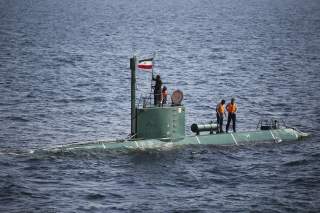We Spotted Cuba’s Only Submarine
Cuba has exactly one submarine. And we finally have a good, recent photograph of it.
Cuba has exactly one submarine. And we finally have a good, recent photograph of it.
Forbes reporter H.I. Sutton was among the first to circulate a tourist’s 2020 snapshot of the Cuba navy’s sole Delfin-class submarine.
The photo depicts the diminutive Delfin pierside in Havana. A nearby trawler offers some sense of scale, emphasizing just how tiny Delfin is.
The Cuban boat is “one of the world’s least-photographed submarines,” Sutton explained. “When a tourist took a photo of Havana’s picturesque harbor, they didn’t realize the intelligence value of what they were capturing.”
The Cuban navy once operated three Soviet-made diesel-powered attack submarines. Those vessels no longer serve in Havana’s much-reduced fleet. “Today the Cuban navy operates a hodgepodge of vintage Soviet equipment, converted fishing trawlers with missiles and helicopters, and an array of improvised torpedo craft,” Sutton wrote.
Sutton claimed Delfin “is active between the capital, Havana, and the remote naval base at Cabanas.”
“From analysis of open sources we know that she has been present in Havana several times in the past year, indicating a modest operational tempo.”
At 70 feet long and 100 tons of displacement, Delfin with its five-person crew and two torpedoes isn’t much, but it’s still “the most impressive of these homegrown vessels,” Sutton explained.
By comparison, a U.S. Navy Virginia-class attack submarine, 377 feet long and displacing 8,000 tons of water with a 135-person crew, boasts nuclear propulsion and more than 60 torpedoes and missiles.
But Delfin’s small size belies its destructive potential. As Sutton pointed out, a North Korean Yono-class midget submarine that’s similar to Delfin in size and capability, in 2010 sank the South Korean corvette Cheonan, killing 46 sailors.
Another rival of the United States is one of the world’s leading operators of tiny submarines. The Iranian navy based its 23 Ghadir-class midget submarines on North Korea’s Yono. It’s possible Cuba also based Delfin on a North Korean design.
Displacing 120 tons of water with a crew of 18 and a top speed of 11 knots, a Ghadir fits just two 533-millimeter-diameter torpedoes. It also could carry sea mines or special forces.
Tehran reportedly has been working on arming the Ghadirs with cruise missiles. The munition’s small size could limit its range, speed and explosive power.
Still, USNI News writer Daniel Dolan warned against underestimating the Ghadirs and Yonos. The same warning could apply to Delfin. Mini-subs could excel at “ambush tactics,” Dolan wrote. Rather than sailing long distances to attack American vessels, they could lie in wait in shallow, crowded waters.
When an U.S. Navy vessel passes nearby, the tiny sub could open fire. Two torpedoes isn’t a lot, in the grand scheme of things. But it might only take one to sink an American ship.
Of course, there’s one important distinction between North Korea and Iran’s submarine operations and Cuba’s. The former two countries each have acquired scores of midget submarines and plan to deploy them en masse.
“The proliferation of these units presents a number of tactical challenges to the U.S. Navy,” Dolan wrote. “As with [fast attack craft], there is a definite tactical quality to quantity. The sheer number of small but lethal threats that have to be considered when operating in the Persian Gulf, when added up, creates an overall high threat environment.” The same could apply to the waters around the Korean Peninsula.
Cuba by contrast just has the one submarine. Havana doesn’t have the option of leveraging numbers in order to create major obstacles to U.S. Navy deployments.
Of course, the Yono that sank Cheonan apparently did so alone. “Just like [fast attack craft], only one Yono needs to slip through a friendly-force defensive perimeter and get within torpedo range to possibly achieve success,” Dolan pointed out.
“We may learn more about Delfin in the coming years,” Sutton wrote. “For now this new photo will be gold dust to defense-watchers hoping to know more about Cuba’s most potent naval vessel.”
David Axe serves as Defense Editor of the National Interest. He is the author of the graphic novels War Fix, War Is Boring and Machete Squad.

